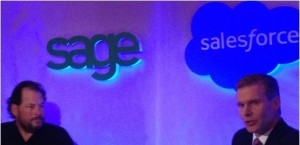In one of the most remarkable partnerships in the Cloud applications market, Sage and Salesforce.com are joining forces to build next-generation ERP applications for the midmarket.
Sage and Salesforce.com used to compete in the Customer Relationship Management applications market with the former selling ACT and Saleslogix desktop packages and the latter undermining those products with its Cloud-based solutions primarily for Sales Force Automation. In 2013, Sage pretty much exited the CRM market by selling ACT and Saleslogix to Swiftpage even though it might still retain a minority stake in Swiftpage.
On the other hand, Salesforce.com has been branching out from its SFA heritage through acquisitions of Heroku for tools and ExactTarget for eMarketing as well as building out its PaaS business now under the Salesforce1 umbrella for mobile apps development and Cloud extensions from an array of on-premise and Cloud-only ERP partners like FinancialForce, Kenandy and Workday, all of which compete with Sage either full time or on a marginal basis.
So the pact between Sage and Salesforce.com suggested that the two have buried the hatchet by pooling resources to help SMBs better leverage the Cloud through an upcoming product called Sage Life. According to Sage, due out in summer 2015, Sage Life allows seamless interconnections between colleagues, customers, partners, suppliers, and other stakeholders.
In addition to Sage Life, the vendor has a number of other Cloud ERP applications including Sage One, an ERP package that has secured 115,000 subscriptions primarily small firms with a handful of employees. Amazon Web Services provides Cloud hosting for Sage One. In the United Kingdom and Brazil, Sage also has different Cloud ERP applications like Sage 300 Online and Sage ERP X3 Online running on Microsoft Azure, AWS as well as other platform partners.
At the event, Stephen Kelly, CEO of Sage, said Sage Life will be interoperable with its other Cloud applications as the new product is geared toward bigger firms with at least 10 employees. Unlike the direct-sales model for Sage One, Sage Life will provide ample opportunities for Sage partners for reselling add-on services.
Despite its history of working with AWS, Microsoft and other platforms, the speed to market appeared to be one of the key factors that drove Sage into the arms of Salesforce.com, a courtship that only started five months earlier. It was around that time when Salesforce.com ended its three-year agreement with Sage’s chief rival Intuit, discontinuing Salesforce for QuickBooks.
With Sage Life, the upside for Salesforce.com could be substantial. After more than three years on the market, Sage One now generates about $14 million in annual subscription revenues. Based on our Cloud infrastructure study here, vendors like Sage could be spending between 15% and 25% on its platform service amounting to an annual payment $2 million to $4 million just on Sage One for providers like AWS.
The payoff for Salesforce.com hosting Sage Life first and other apps later – which could result in millions of paid subscribers in a matter of years – is likely to generate tens of millions of dollars in incremental revenues for Salesforce1. In its latest fiscal year, Salesforce1 and other platform products raked in $746 million in sales, or about 14% of its total revenues.
All Carrots and No Stick
Both Sage and Salesforce.com executives said the deal was stuffed with all carrots and no stick, meaning that the latter is expected to provide hefty incentives for Sage and its partners to promote and market Sage Life extensively.
The remaining question is what will happen to the arrangements between Sage and AWS, or for that matter, Microsoft. Kelly said Sage will continue to partner with AWS and Microsoft. Mark Benioff, CEO and co-founder of the $5-billion Salesforce.com, was effusive on his company’s ties with Microsoft, which was on full display during last year’s Dreamforce introduction of Salesforce1 for Windows, Salesforce for Office, and Power BI for Office 365 and Excel integrations with Salesforce.
The new executive team at Sage, with Kelly joining the company in November 2014 and his subsequent appointments of a number of global heads running strategic product lines like Sage Life, exemplifies the speed of change at the $2.3 billion company, which is the second-largest software vendor in Europe behind SAP. Sage executives at the event echoed the view that “Sage is a different company now.’’
By the same token, Salesforce.com could well become a different company. At the event, Benioff reaffirmed his conviction on company expansion plans, despite continuous news reports on its being pursued possibly by Microsoft that could result in the world’s largest acquisition of a software company.
In response to an ARTW question on the status of the buyout offer and the future of Salesforce.com perhaps without Benioff’s active involvement, he said negotiations were still under way. Then he talked at length about the accomplishments of Salesforce.com(especially on its philanthropic activities) as well as his desire to double its revenues to $10 billion.
Deal or no deal, Salesforce.com’s ability to double in size either as an independent company or part of another entity could be open to different interpretations.






